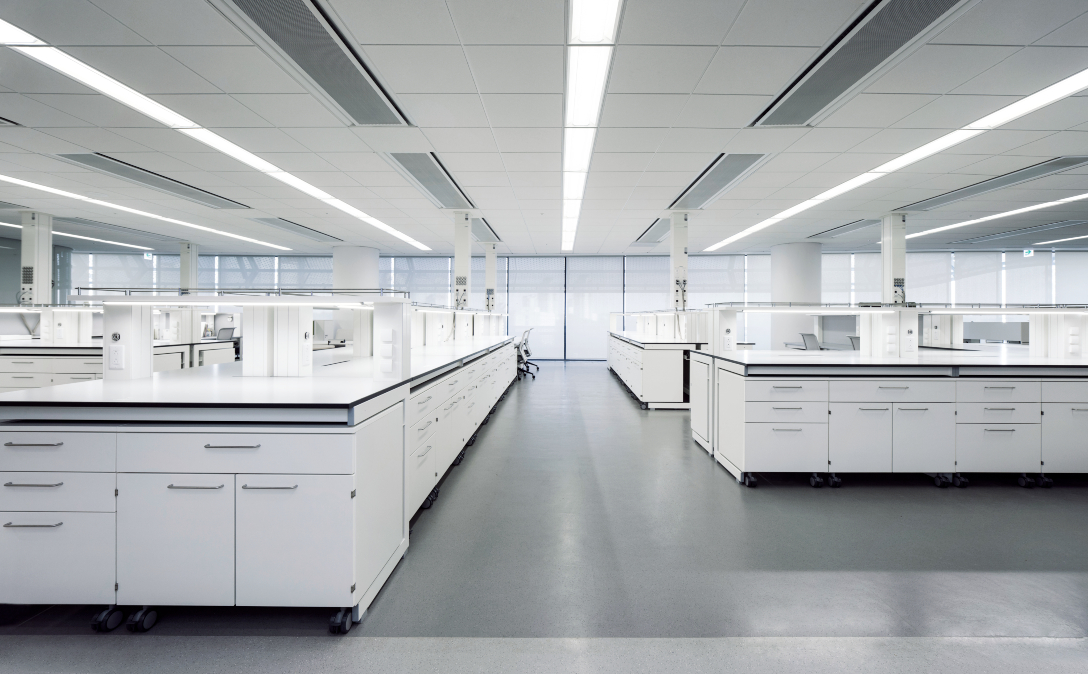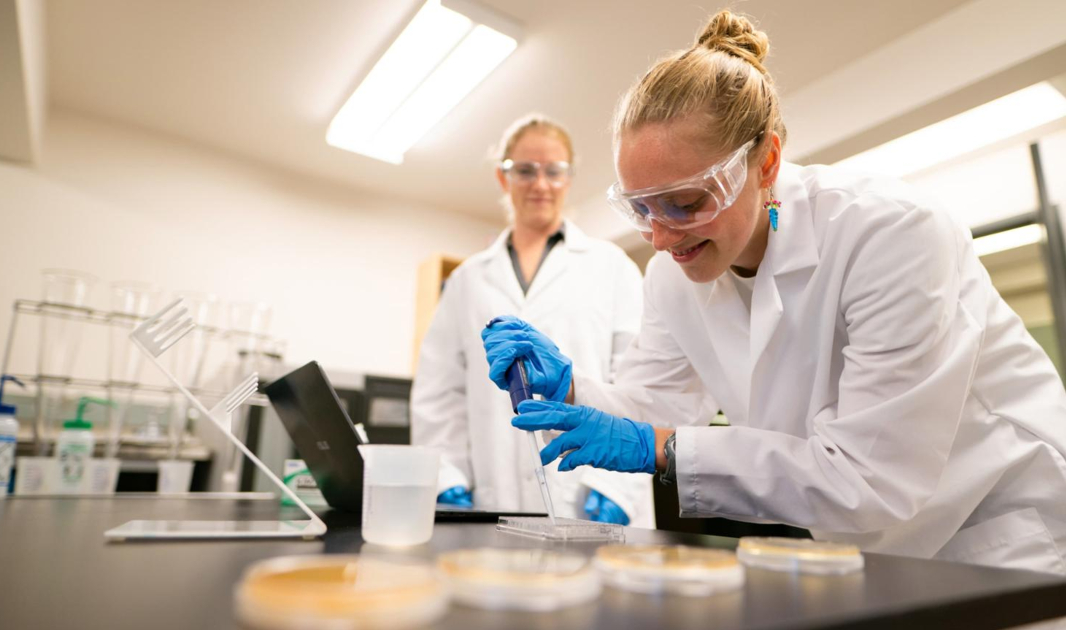Laboratories play a vital role in our lives. Within these spaces, ground-breaking scientific breakthroughs are continually being made, whether that be by happy accident, likeDr Alexander Fleming stumbling upon penicillin whilst growing bacteria in a petri dish back in 1928, or via targeted trials such as the manufacturing of the life-changing Covid-19 vaccines in 2020.
For scientists, laboratory managers and life sciences teams to flourish, they require specialised environments which are practical and productive but also creative and collaborative. This laboratory design can be achieved through thoughtful planning in terms of layout, technology, equipment, furniture and furnishings.
At Evolve, we love to work alongside our science clients to deliver innovative laboratory designs specific to their bespoke business needs, from wet labs requiring specialised air extraction to tackle potentially harmful chemicals, to electronics and software labs needing multiple power-connected worktops.
Our top tips for achieving the perfect laboratory design
1. Let the scientists take the lead
Before you can design a laboratory, you have to understand its needs. Is it a wet lab or a dry lab? Will it be handling volatile chemicals or need cold storage facilities? What about soundproofing, vibration control or plans for future expansion?
a. Gather the stakeholders together – including lab managers and users, scientists and maintenance staff – and discuss function, workflows and processes.
b. Ascertain the critical requirements, from space needs to temperature control, air changes and pressure regimes, to create the most efficient laboratory blueprint.
c. Establish a shared vision, and use it as your guide throughout the design and fit out process to ensure it is executed concisely.
2. Lab safety requirements
Safety is a top priority in laboratory design, with the vast array of different chemicals and gases in regular use elevating the risk of fire or injury. Consider the following five steps as a minimum:
a. Ensure you have a robust chemical management strategy built into your design plan, especially if the substances being handled are hazardous, flammable or toxic.
b. Include chemical storage ‘control areas’, biosafety cabinets and emergency shower/eye wash stations.
c. Install fire protection and detection systems and clearly signpost fire exits.
d. Procedures should also be established for the safe transportation of chemicals in and out of the laboratory.
e. Include fume hoods, which help exhaust harmful vapours, gases and aerosols during research, whilst providing a protective shield between the scientist and the chemical reaction.
Evolve’s in-house experts can advise on safe laboratory procedures, including oxygen depletion monitoring systems, extraction and cooling solutions.
3. Adequate laboratory airflow
Let’s talk HVAC – which stands for Heating, Ventilation and Air Conditioning. Crucially, all three need to be at optimum levels in laboratory design to create both a safe and comfortable environment for research to take place.
The ventilation component of HVAC supplies fresh, clean air to the laboratory to displace contaminated air and dilute it to safe levels. How much ventilation your laboratory needs depends entirely on the type of work it does, and air quality may differ from one room to the next. So, rooms with fume cupboards and higher containment, for example, will need a greater amount of air changes.
Natural ventilation can also be an option for some laboratories, though windows should be fitted with insect screens, to ensure insects which can carry diseases do not enter the laboratory setting.
4. Abundant light in the lab
Laboratories need specific lighting, which is generally far higher in luminance than your average office. However, just like ventilation, lighting levels for laboratories vary according to their purpose.
Also, with the trend for lab design moving towards creating more flexible spaces, then collaboration areas may have different lighting requirements to close-work zones, which is where a layered lighting system works best. This approach uses overhead lights combined with task lights to meet prescribed levels.
What to consider when choosing laboratory lighting
- When choosing lighting, remember to bear in mind the finish colours of floors, ceilings and walls, to minimise glare and reduce the risk of eye fatigue.
- On top of artificial lighting, an abundance of natural light can do wonders for staff morale (boosting health and productivity), so let the sun shine in through floor-to-ceiling windows or large sky lights, where possible.
- If you’re designing a laboratory which has no access to natural light, consider specialised lighting which mimics circadian rhythms, helping staff to perform more efficiently in the day and sleep better at night.
Bolster staff wellbeing by giving them access to fresh air too, providing a refuge away from the strict clinical environment, perhaps on balconies or in designated outdoor areas with pleasant seating and greenery.
5. Layout and laboratory furniture
Whatever the nature of your laboratory, its layout and furniture should enable scientists and researchers to work as smoothly and comfortably as possible. Benches used for admin work and simple preparation should ideally be positioned around perimeter walls to improve access and workflow. This also allows ample floor space for mobile equipment to be transported through the laboratory safely.
Wet labs
Commonly used for manipulating biological matter and chemicals – will need sinks, fume hoods and piped gases plumbing, plus chemical-resistant countertops (preferably incorporating a lip to avoid liquid-run off).
Incorporate flexible engineering services to supply air, water, electricity and vacuum systems, with easy connects and disconnects at walls for fast equipment hook-ups.
Dry labs
Which are predominantly electronics-focused – should include mobile storage, adjustable shelving, and multiple electric and data cabling access points.
To avoid clutter on worktops incorporate overhead cabinets and under-bench storage, with agile shelving options which can be altered in line with each new project.
Lab work is often undertaken whilst standing, however when it’s time to take a seat, the appropriate seating is important. Often draughtsman height chairs are chosen, which allows technicians to sit, perch or stand as needed.
Height adjustable lab benching is also available, but the furniture should be carefully selected based on how it will be used. Our team of experts at Evolve can guide you through the available options based on the specific needs of your organisation.

6. Breakout spaces
Laboratories are controlled, clinical environments, where scientists, lab managers and researchers often fly solo. Yet some of the best results are achieved through collaborative thinking, so include warm and comfortable ‘breakout spaces’ in your laboratory design to spark a meeting of brilliant minds.
These could be social hubs, decorated in uplifting hues and filled with lush planting, to harness the positive power of biophilia, or even ‘collision’ spots, dotted along circulation routes where employees’ cross paths and share ideas.
Encourage these serendipitous encounters by adding built-in window seats, little nooks, wi-fi connection and, of course, tea and coffee facilities!
7. Sustainable lab design
We’re all far more conscious of our carbon footprint these days as we witness climate change in motion. It’s especially important that life sciences businesses are aware of their sustainable responsibilities as laboratories typically use five times as much energy and water per square foot as your average office building.
But how can you limit your environmental impact when designing your laboratory space?
Energy and water consumption are two of the biggest areas where labs can improve their efficiency so consider more sustainable options. Simple measures like adjusting equipment settings, and turning off lights and appliances when not in use, can save energy over time and prolong the lifespan of the specialist equipment. Use eye-catching signage near switches to remind staff to do their bit.
Perhaps also include a recycling strategy in your laboratory design brief, encouraging staff to source recycled materials (choose glass over plastic, maybe?), and recycle disposable plastics.
8. Get in touch with Evolve’s laboratory design team
If you’re a life sciences business wondering where to start with your laboratory design, Evolve offers a full turnkey service, from concept to completion.
Not only do we carefully plan and design your laboratory space, but our in-house teams can devise dynamic office facilities to complement lab designs, manage relocation, supply bespoke laboratory furniture and set up your mechanical and electrical services.
Mark Bonello, Head of Technical Services at Evolve, said: ‘The incredible work that takes place in laboratories, from AI advances to cancer breakthroughs, make them one of our most valuable assets. And, post pandemic – just as offices have seen a shift toward flexible working – laboratories also need to be adaptable in their design.
‘Creating safe, agile lab space, with flexible features such as movable work benches and multiple access points for utilities, means scientists can shift seamlessly from one project to the next, keeping up with the fast pace of innovation.’
Get in touch to find out how we can design a specialised space for you which supports great minds as they create and innovate.
You may also be interested in
Industry insights, innovative ideas and exciting announcements from Evolve
Evolve’s commitment to you
Evolve helps medics, researchers, technicians and scientists increase efficiency and productivity every day.
We are a leading supplier of laboratory equipment and analytical instruments for scientific, R&D, educational and medical laboratories in Malta, Europe and beyond. We back all our lab equipment products with unbiased technical assistance to help you solve your application needs.
At Evolve, we always…
- Put our customers first – We dedicate our energy and efforts to sourcing great quality products and exceeding customer service expectations.
- Act with integrity – We build relationships based on honesty, trust and transparency with our customers, colleagues and the communities we serve.
- Strive for simplicity – We believe that simplicity lowers costs for our customers, increases efficiencies and makes life easier for everyone.
- Enjoy what we do – We work hard, try our best, share and celebrate success and love what we do. It makes our lives better and results in better customer service.


